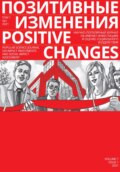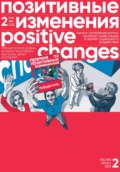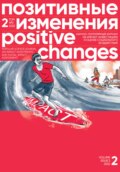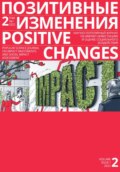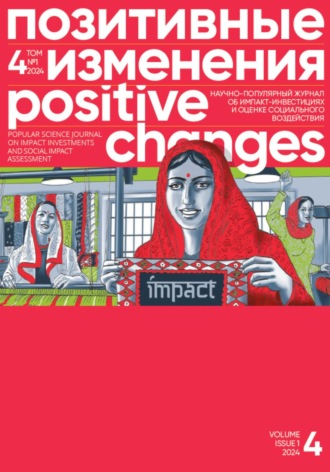
Редакция журнала «Позитивные изменения»
Позитивные изменения. Том 4, №1 (2024). Positive changes. Volume 4, Issue 1 (2024)
“Small Territories – Big Future”: A Development Technology for Northern Territories Through Local Community Engagement
Andrey Borodkin
DOI 10.55140/2782-5817-2024-4-1-45-57

Fostering community activity in small, remote territories is a challenging task. Aligning these initiatives so that they sustain themselves beyond the end of project financing is even more challenging. This article is devoted to the “Small Territories – Big Future" program, which has been implemented in the Arkhangelsk region by the Garant Group of Non-Governmental Organization for the past decade, leading to significant changes in the life of this northern territory.

Andrey Borodkin
Editor-in-chief, Garant Group of Non-Governmental Organization
PREREQUISITES FOR THE EMERGENCE OF THE “SMALL TERRITORIES – BIG FUTURE” APPROACH
“Garant” is one of the oldest NGOs in Russia, which celebrated its 25th anniversary in 2023. From the outset, the organization has been dedicated to the development of small territories in Russia’s North. The area has always had strong traditions of activism, mutual aid, and self-organization. There were leaders poised to lead, yet they lacked expertise in social project design.
The “Small Territories – Big Future” initiative started in 2014. By then, substantial experience in implementing territorial development programs had been accumulated by Garant and other organizations. The efforts of the Institute for Public and Humanitarian Initiatives headed by Gleb Tyurin deserve special mention. The experiences from implementing his territorial development programs in Arkhangelsk region are chronicled in the book “The Revival of Russian Villages,” published in 2007. Elena Shomina, founder of the Territorial Public Self-Government (TOS) and the Neighborhood Development Movement in Russia, has repeatedly visited the Arkhangelsk region to foster its development. Since 2006, Garant has consistently organized grant competitions for social projects targeting regional NGOs and budget organizations, funded by the consolidated budget. Thus, by 2014, the region had established a landscape of social initiatives with unique methodologies and practices.
The “Small Territories – Big Future” program marked a new phase in the methodical development of the region’s small territories, starting in the Pinezhsky District. By that time, its inhabitants had already launched several independent social initiatives. Garant sought to devise a methodology that would transcend individual project implementation and advance the development of the territory as a whole.
Following a visit to the Pinezhsky district, Garant’s team conducted extensive analytical research. The research examined, for instance, documentation confirming the receipt of regional and federal subsidies and grants by NGOs, small businesses, and TOSs, along with demographic data for the district. This experience was taken into account in the development of the program methodology. Let us examine it in greater detail below.
STARTING WORK WITH SMALL TERRITORIES: TWO APPROACHES
Garant’s methodology is predicated on a key principle: in small territories, it is imperative to first identify local leaders willing to champion change and oversee the evolution of local initiatives.
In essence, it is about uniting people into a community.
Two strategies exist for locating such a team of leaders. The first involves building on the foundation of an existing team of motivated individuals (if present) and initiating work with them. This approach has its merits: the group is already formed, its members have collaborative experience, understand each other, and generally share common values. However, there are also risks: individuals have their specific interests and networks, and special efforts must be made to motivate them to broaden their connections.
The alternative is to form such a group from local leaders or those aspiring to become leaders. This process is more resource-intensive and protracted. Yet, if successful, it offers the possibility to unite a diverse group of active individuals with varying interests and experiences, thereby greatly enhancing the potential for regional development.
During this initial search for proactive community members, it is crucial for organizers to understand certain nuances of working with small territories. Otherwise, the effort expended may prove futile. It is important to pay close attention to the following:
• Territorial development can only occur if local activists are ready to become the catalysts for change. It must be underscored that shaping individual leaders is not the responsibility of the organizer. This objective is overly labor-intensive and is unlikely to result in systemic changes within the territory. The organizer’s role is specifically to unify activistleaders into a cohesive community with shared objectives and to equip them with the necessary tools for territorial development. If such activists are not yet present, it may be wise to reallocate efforts to a different region.
• Residents should be engaged in collaborative ventures that prove successful, assisting them to surmount the “learned helplessness” syndrome.
• Engagement arises when people are moved by issues that resonate with their personal interests. It is unfeasible to instantly involve people in broad societal challenges – initial collective initiatives must be resident-centered. If residents of a small territory are immediately briefed on the entire strategic vision for community development and its potential to improve quality of life and infrastructure, their inclination to participate in public affairs is unlikely. Conversely, revealing the objectives incrementally, such as first being able to bring children to a new library space, then advancing to replace street lighting, and eventually constructing a new community center, tends to enhance engagement. Marina Mikhailova, director of the Garant Group of Non-Governmental Organization, articulates it as follows: “Trouble, dreams, and love drive people toward activism.”
• Not everyone is inclined to be equally proactive. The majority of people are prepared to contribute as participants, not as initiators or organizers, and they should be granted that chance. Yet if everything is done for the residents (termed “inflicting good” in the non-profit sector) rather than by the residents themselves, they will not take initiative.
• Observing tangible outcomes takes time.
Swift success in small territory development is typically tied to specific examples. Grasping the full scope of community advancement may necessitate patience, sometimes spanning two to three years.
• Focus on cultivating relationships with local government bodies. Workflows are streamlined and outcomes are more impactful when the organizer either secures backing from the local administration or at least informs them of planned initiatives.
ORIENTATION WORKSHOP: SEEKING STRAIGHTFORWARD SOLUTIONS TO COMPLEX CHALLENGES
In the “Small Territories – Big Future” initiative, Garant opted for the latter approach and extended invitations to proactive citizens interested in nurturing local initiatives. Potential activists were offered the opportunity to enroll in a training program aimed at empowering community leaders.[56] The application form took into account experiences from both the first and subsequent visits to the Pinezhsky District. An analysis was also conducted to identify proactive leaders within the small territories of the North.
Typically, only residents from territories where at least five individuals have applied are invited to participate in the program. Participants arriving at the orientation workshop may live in the same area but often are not acquainted with each other. It is during the workshop that they discover mutual interests and begin to form a community.
After assembling the leadership group, it is crucial to conduct an orientation workshop. The significance of this step is frequently underestimated, with a hasty progression to social project planning. It is essential, however, to help activists comprehend why they have chosen this path, why it matters to them, their vision for personal future achievements, and what changes they aspire to make in their community.
The initial segment of this workshop should focus on exploring the participants’ personal motivations:
• Why have I chosen to participate in this program?
• What personal outcome am I seeking?
• How will achieving this result impact my life?
Another critical component of the orientation workshop involves discussing the shared interests of participants from the same territory:
• What changes do we collectively aim for?
• Why are these changes important to us?
• What resources do we have, and what are we lacking?
• Who else in the community may be interested in these changes?
Not every participant will act upon the discussed ideas. Some will say immediately after the workshop that the role of a local activism coordinator is not what they have dreamed of. Recognizing this promptly is valuable.
Others may decide to pursue their specific initiatives and projects, preferring to take action themselves rather than motivate others. This is also a good result, which means that future coordinators already have someone to rely on.
Inevitably, some individuals within the group will reinforce their resolve to be catalysts for developing local engagement. These people are poised to become pivotal agents of change in their living environment. The size of each group differs by region, but it is estimated that at most 25 percent of members typically assume such proactive roles.
Two full days are recommended for the length of the orientation workshop. If led by a single facilitator, the group should not exceed 25 individuals. Ensuring that the workshop environment is optimized for group activities is essential. Creating an atmosphere conducive to networking and interaction is key, hence incorporating interactive engagement is advisable.
The orientation workshop aims to achieve the following objectives:
• Clarify for the initiative group members the goals and anticipated outcomes of the planned activities, and how these results will be utilized.
• Acquaint the participants with the survey questions, ensuring clarity on the intentions behind each inquiry.[57]
• Conduct a briefing on the questionnaire process.
• Engage in a practical run-through of a sample questionnaire, mirroring what will later be conducted in their respective communities. Participants may pair up and conduct mock interviews amongst themselves during the workshop. This exercise will help pinpoint any challenging questions and clarify any ambiguities.
• Provide guidelines on how to analyze the gathered information and consolidate it into an aggregate table. It has been shown that initiative work flows more smoothly when a group member is pre-designated to handle the compilation of data from all surveys into a table. This approach will minimize errors or at least standardize them, making them easier to identify and rectify.
• Prepare a comprehensive analytical report from the initiative group on their data collection methodology.[58]
IT’S NOT JUST ABOUT YOU; IT’S FOR THE COMMUNITY: THE IMPORTANCE OF NOT OVERLOOKING THE SURVEY
After the workshop, it is critical to avoid immediately jumping into social design activities and instead prioritize the collection of data about the territory’s residents. This is an essential consideration since leaders may have their vision for the community, which could differ significantly from the members’ perspectives. The aforementioned questionnaire, as discussed in the orientation workshop, will assist in this regard.
The interview questionnaire should be adaptable for use across all territories where the organizer is active. This facilitates not only the consolidation of data from a specific area but also enables comparative analysis across different territories. It is advisable to limit the questionnaire to 25–30 items to avoid complicating the process excessively. Yet, overly condensing the questionnaire should be avoided to maintain its informativeness.
Obtaining current demographic information about the gender and age distribution within each territory is also essential. This can be achieved by consulting regional statistical offices, local administrative bodies, or requesting information from local self-government entities. Understanding the demographic breakdown is crucial for grasping the resident dynamics of each territory. For instance, if you aim to gather 80 surveys with the demographic split of 53 % female and 47 % male in the area, accordingly, then the task would be to conduct interviews with 42 women and 38 men.
Questionnaires can be tailored by activists in each territory, adding questions they deem significant. Generally, the survey should reflect:
• The residents’ general satisfaction with their territory;
• A priority ranking of urgent and less pressing issues;
• Issues that residents believe they can address with their initiatives;
• Satisfaction levels with key aspects of life;
• Residents’ migration intentions and their attitudes towards their territory;
• A listing of active individuals, community groups, and non-profits active in the territory;
• The potential for civic engagement;
• Any consensus or discord among residents about the importance of local issues.
Subsequent analysis of the survey responses should proceed as follows:
1. Conduct a cumulative analysis of the data across all questions and territories. This process will yield average results.
2. Create graphical representations for the distribution of responses to each question.
3. After aggregating the data, examine the details within individual territories.
4. Identify and note any significant deviations from the average results across studied territories. Survey findings can be utilized in crafting grant applications, detailing projects, and implementing initiatives.[59]
CREATIVITY IN METHODOLOGY: HOW TO CONDUCT AN EFFECTIVE PROJECT SESSION
So, the organizer already has a group of leaders and the qualitative results from the analysis of social life in the community. It is time to focus on social initiatives. Let us look at an example of such an event – a project session. The session comprises eight stages.
Stage 1. Introduction. The primary goal is to initiate a discussion with participants about local problems, needs, and opportunities in an open-dialogue format.
Stage 2. “Meet the People I know”: The main goal is to facilitate introductions among participants. Ideally, create groups of people who are less acquainted with each other; the optimal group size is 5–8 people, with no more than 5 mini-groups.
Each group is tasked with preparing a 10-minute business card-style presentation that captures the group’s name, the average or total age of the members, and unique characteristics. Each group will then present themselves.
During the discussion, you can ask how participants’ moods have changed or if they’ve learned something new about their peers. Take note of the common things and uniqueness that participants highlight.
Stage 3. Focus on the Past: The aim here is to emphasize the importance of acknowledging the past when planning for the future.
This involves the creation and analysis of the “Timeline.”
Participants will reflect on significant events in three areas: their personal lives, their local area, and their country. Each person receives three stickers, each of a different color representing one of the three areas. One event is recorded on one sticker. For each direction, there should be three stickers (representing three events). The events can be from any period.
The stickers are placed on the “Timeline.” Participants may be asked to write down the year or the exact date of the events on their stickers. It is common to question which events to write down – only positive ones or any at all? Note that they should indicate the events that are significant to them, and the interpretation of significance is up to them.
Participants are then divided into three groups, each analyzing one of the three directional areas. The task is to examine the events on the “Timeline” for each area (country, territory, self), identify common themes that are relevant to the group, note any peculiarities, and attempt to draw conclusions. Each of the three groups will present their findings. This will be followed by a group discussion on how our past experiences affect our lives today and how we might use this understanding in the present and future.
Stage 4. A Glimpse into the Present. The objective at this stage is to capture the current situation in the territory and reflect on the main trends (both positive and negative), as well as existing community resources available for the implementation of social initiatives. This stage consists of two significant exercises.
The initial task is the creation of a “Resource Map” for the territory. This exercise implies collaboration in small teams. Each sub-group is to creatively draft a resource map on a flipchart, which can be descriptive, illustrative, or schematic. It is vital for participants to understand that the term ‘resources’ here extends beyond just finances to encompass natural elements, community skills, and touristic appeal. The allotted duration for this task is 20 minutes. Documenting the outcome on a flip chart is a requisite step. Subsequently, each group is expected to deliver a presentation of their resource map. An example of a “Resource Map” can be viewed in Figure 1.
Following all mini-group presentations, a discussion should take place regarding which resources are commonly identified, which resources have been overlooked and reasons why, which are unique, and their potential as focal points for development. Overall conclusion: Determine which existing resources on the territory could serve as a foundation for project realization without the need for extra funding.
Next, participants are encouraged to individually note down in their journals what aspects of their community and region make them proud and what they regret. Participants must list at least five “prouds” and five “regrets” on separate stickers and then affix them to a collective sheet – the “Map of Consciousness.” Participants should then engage in a dialogue to reflect on their noted items. The sum of “positives” and “negatives” tallied on the stickers should be no less than 20 for each category.
Participants then receive 3–4 small stickers each to denote on the “Consciousness Map” what they deem the most critical positive and negative attributes of their community.
With the facilitator’s guidance, participants review which “prides” and “regrets” got the most attention and which aspects were overlooked. The discussion should lead to a consensus that while all noted points on the “Consciousness Map” are significant, there are certain priorities; some actions need to be addressed immediately, while others can be deferred.
Stage 5. Focus on the group’s core priorities. The objective of this phase is to capture what participants are currently engaged in, fostering a sense of achievement and addressing areas of regret within their community.
Figure 1. “Resource Map” Example

Discussion is organized within small groups. This is followed by brief presentations from each group. The essential realization for participants is that numerous activities are already underway within the territory, albeit in a fragmented manner. Recognizing that shared interests and collective goals lead to stronger outcomes is key. To understand the overall goal, you need a picture of the future.
Stage 6. Envisioning the Future. Participants are invited to create a shared vision of the territory’s future, in about 10–15 years, depicting a place where they aspire to reside.
Creative sessions are organized in small groups. Groups are given the creative task of constructing a visual representation, such as a collage or model, using various materials and media. In their visionary creations, participants are encouraged to incorporate the territory’s historical context (as depicted on the “Timeline”), its current state (“Resource Map” and “Consciousness Map”), and prospective future.
Each group is then expected to present their results in a creative way. It is important that the presentation is made as if the future has already arrived: this could be a tour of the territory of that time (for example, the year 2035), or a letter to ancestors from descendants living in 2035, or a news story from 2035.
Subsequently, a group discussion should be held to identify recurring themes within these envisioned futures, understand the distinct elements presented, and explore their origins. It is critical to assess whether the envisioned futures are grounded in the resources that are currently available within the territory.
Stage 7. Action Planning. The goal is to craft project ideas that are feasible for immediate implementation within the territory, thereby bringing the envisioned future within closer reach.
Participants are asked to identify initiatives that they can initiate right now, to take concrete steps towards the future they envision. They form groups centered around these ideas and proceed to outline project proposals on flipcharts, defining the project’s name, objectives, and answering fundamental questions about the purpose, target audience, actions to be taken, collaborators, and expected outcomes.
Groups then present their project concepts to other participants for feedback and potential collaboration. Those interested in a particular idea are encouraged to join the corresponding project group to refine and develop the idea further.
Stage 8. Forming Initiative Groups. Session participants are encouraged to sign up for project groups, share their contact details, and the group initiator will arrange a subsequent meeting to further discuss the project initiative. The session includes discussions on resourcing for initiatives with the assistance of the Resource Map, and potential for participation in grant competitions, both at local and federal levels. The session ends with a roundup and collection of feedback.
PROJECT SUPPORT DOES NOT END THERE
Note that the project session model described above is just one example of engaging with territorial leaders. Organizers may modify this model, incorporate external speakers, and include gamification elements.
It is important to recognize that the organizer’s role continues beyond such sessions. The organizer will continue to support the initiative groups in the territory, visiting them in person and conducting new sessions. “Garant” has coined a term for these sessions as “project workshops.” Essentially, these are social design workshops reoriented towards practical application. Such workshops typically span a full day or preferably two days and are attended by project groups (comprising 2–3 individuals each) that have a well-delineated idea, documented in writing, even if only briefly, on half a page. Ensuring there is a clear project outline is vital; the project group should discuss and document the idea.
During the workshop, it is crucial to explain the concept of a project to group members: the logic of project development, the breakdown of project components, and how to compute the necessary resources. For guidance, the manual “Fun Project Management: From Idea to Project. Part 1.”[60]
RESULTS AND EXAMPLES OF PROJECTS As previously mentioned, the outcomes of such extended efforts can be deferred. Here are some quantifiable results from applying the Garant methodology:
• A network of 12 resource centers each led by strong leaders. All of them have been established across various districts of the region owing to the program;
• More than 50 projects successfully realized under the program across four directions;
• Participation of over 20 resource centers from smaller regions.
Let us examine in greater detail two successful projects facilitated by this methodology.
The “Born in Ustyany” Project. This initiative was implemented in the Ustyansky district of the Arkhangelsk region.[61] It encompassed several initiatives:
• “Taste of Childhood”: A series of interactive events centered on Ustyany’s traditional cuisine for children and youth. One of the results was “Tasty Talks” – a compilation of traditional recipes from the region’s grandmothers.
• “Ustyany Style”: Creating a modern, stylized youth collection featuring traditional Povazhye painting, embroidery, and lacework.
• “We Live Modestly, But Our Echo Travels Far”: Involving youth in the documentation and promotion of local events.
• “Ustyany Surnames”: Hosting short lecture evenings focused on the history of local surnames. Through the project’s realization, the district’s youth became acquainted with their heritage, discovering not just outdated crafts but opportunities for innovation and entrepreneurship.
The project creator, Natalia Tsokorova, participated in one of Garant’s orientation workshops, utilizing the methodology we have detailed above. After the project’s conclusion, Natalia Tsokorova transferred her experience to the Ustyansky District Cultural Center, contributing to the territory’s comprehensive development. The establishment of the Ustyany Hospitality Communication Center, a VK community and website ensued to attract tourists and investments to the region. In an interview, Natalia recounted that approximately 70 % of the employees from the municipal cultural institution where she works underwent project management training and are now independently applying for grants. She estimated the total amount of funds raised from various sources for cultural development and preservation of the district’s traditions to be around 4 million rubles within the first three years after the “Born in Ustyany” project. Quantifying the exact impact of Garant’s methodology on the region’s development is challenging, yet the qualitative changes are conspicuously evident.
Fedorova Gora Project This project is underway within Shenkursky District, Arkhangelsk Region, specifically in the village of Vlasyevskaya. Locally known as Kremlikha, the village has around 50 inhabitants but lacks a club, library, post office, store, or any communal space for gatherings and social interaction.
The residents themselves have improved their living environment, enhancing the high bank along the meadow with benches and waste bins. They have also encircled the territory with informational stands designed in the style of traditional Russian log hut walls. On these stands, they have displayed interesting historical facts about their village, making it a place of interest not only for locals but also for tourists. Now this location has transformed into a focal point of attraction for both the community and visitors alike.
“Fedorova Gora” is a result of efforts of a large team that united local residents, TOS participants, entrepreneurs, and the local administration. The project today for many is an illustration of how life, even in the smallest and most inconspicuous village, can become interesting thanks to its residents.
At first glance, the quantitative results of the project are modest – one observation deck in a small village. But this project initiated a whole cascade of qualitative changes. Kremlikha now has its own page on the social network VK, which has almost 600 subscribers.[62] The initiative group managed to implement several more projects even after the completion of the project:
• Equipping a space for sports and leisure with football goals and volleyball posts;
• The family-oriented tourism project “Surrounded by Nature”;
• The project for crafting and marketing artisanal souvenirs titled “Craftsmen’s Village.”
Today, Kremlikha evolves from an abandoned settlement into a hub attracting tourists, while the initiative group takes part in national contests and forums. The inception of the observation deck project was the catalyst for these transformative developments.
In other regions: In 2022, the “Small Territories – Big Future” model was employed in the “Development of Small Territories of the Novosibirsk Region” initiative. The Siberian Center for Support of Community Initiatives, in collaboration with the Novosibirsk Region’s Ministry of Regional Policy using Garant’s methodology, conducted comprehensive activities with local activists, which included orientation workshops, surveys, and project development sessions. These efforts resulted in multiple initiatives across small territories, such as:
• The Cheerful Children’s Hospital project in the Kirovsky district, creating entertainment programs for pediatric hospital patients;
• The SciGraff project in the Koltsovo settlement, featuring an artistic mural on a kindergarten wall.
The organizers highlighted that the project’s progress underscored the significance of shifting from grant-dependency to a more systematic approach in nurturing small territories’ development.
KEY INSIGHTS
Thus, a few principal strategies can be distilled for engaging with local initiative-driven residents in small territories as part of the “Small Territories – Big Future” project:
• Identifying local leaders and fostering their collaboration;
• Educating local leaders on community engagement methodologies;
• Assisting leaders to widen their community network;
• Involving people in envisioning a collective future;
• Facilitating opportunities for residents to form new acquaintances;
• Creating platforms for shared community endeavors;
• Supporting initiatives both in spirit and financially, enabling residents to realize their aspirations effectively;
• Actively and inspirationally promoting activists’ accomplishments and encouraging them;
• Energizing leaders by offering spaces for dialogue and exchange of ideas.
The methodology can be enhanced by integrating additional elements or refining existing ones. Essentially, it is about empowering small territory residents to independently experience and appreciate active engagement and to savor the fruits of their accomplishments. It is when residents firmly believe that their collective future hinges directly upon their actions that true change can ensue.



